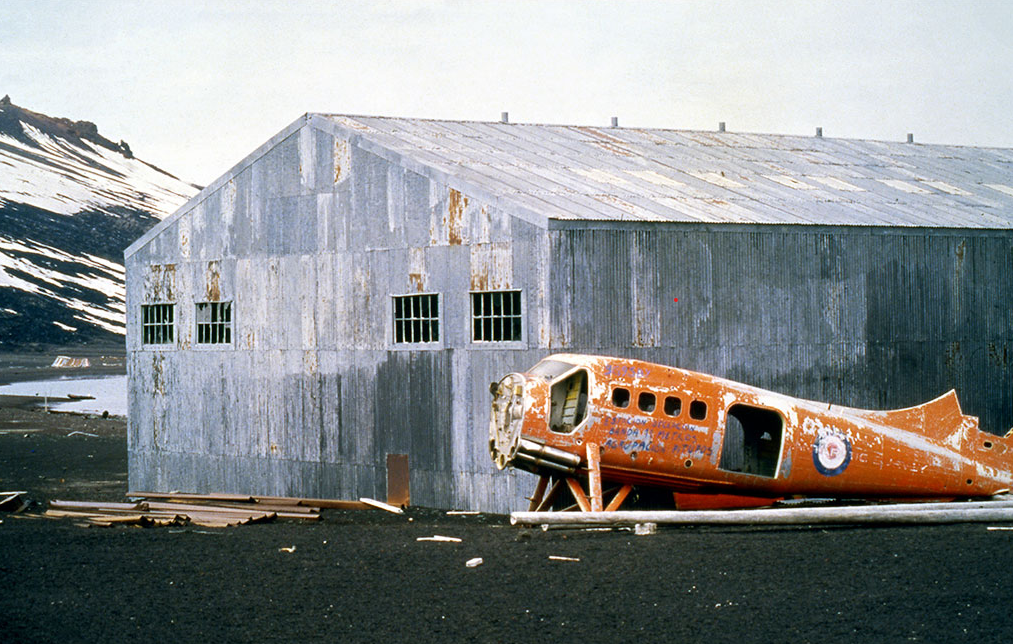Header Photo: Keith Holmes
Aircraft VP-FAK DHC-3 Otter c/n 294 (Continued)
The official BAS history of Otter VP-FAK reads as follows:
“Fitted with wheel skis. Wintered and serviced at Deception Island. Operated during summers from Adelaide Island from 1960 / 1961 onwards. In its first season it helped to establish the base at Fossil Bluff, which it continued to re-supply over the next few years. Flying from Adelaide Island it flew in support of field teams and dog parties. It also flew from Stonington. Damaged by gale at Deception Island 6 October 1961 and by crevasse accident at Adelaide Island 19 December 1964”.
This crevasse accident is described as follows:
“On a flight to Keystone Cliffs damage was sustained on the bottom fuselage aft of the main loading doors. A runway was marked with flags and the Muskeg tractor was driven along the proposed landing strip to ensure it was crevasse free. As the Otter was turning at the end of the marked runway for take-off, it went off the runway and the tail ski sank into a crevasse. Fortunately the pilot was manoeuvring the aircraft at nearly full power and the aircraft had enough momentum to come out of the hole by itself. The damage was extensive but was repaired and FAK continued in service. The rear fuselage and other parts from Otter VP-FAL (377), which had been destroyed in a crash on Adelaide Island in December 1964 were used in the repair of VP-FAK.
The first airborne radio echo sounding in the Antarctic was carried out using FAK during the austral summer of 1966 / 1967. It made its last flight, from Adelaide to Deception Island on 7 March 1967. It was grounded due to extensive metal fatigue found in the fuselage at the end of that season, on 26 March 1967, and was deleted from the BAS active inventory and parked at the Deception Island base. It had flown 981 hours in BAS service. Parts from FAK were used for Otter VP-FAM (395) when it was rebuilt in early 1969. The Deception Island base was closed due to a volcanic eruption in December 1967 and the BAS operation moved to Adelaide Base T on Adelaide Island. The fuselage of VP-FAK remained at Deception Island, lying outside against the abandoned hangar. It was still to be seen there in 2004, thirty seven years later.

Over the years, Deception Island was visited by many tourists to the Antarctic, and photographs of the abandoned Otter were circulated around the world on the web, arousing much interest in the aircraft despite its very remote location. As far as the BAS was concerned, their former base at Whaler’s Bay on Deception Island was designated as an Historic Site and protected under Antarctic Treaties, as were all artifacts located there, including Otter FAK. It appears however that some individual did not agree with this interpretation, claimed the right to salvage the Otter and threatened to do just that. To prevent that happening and to preserve their historic Otter, BAS took action in April 2004.
The logistics support ship ‘RRS Ernest Shackleton’, which was engaged on a clean up of abandoned BAS bases, was diverted to Deception Island to collect the Otter, arriving there on 3 April 2004. This proved quite a task. First of all the volcanic ash all around the aircraft had to be dug away and a crane used to lift the Otter fuselage onto a trailer, on which it was to be towed to the beach. From there the crane lifted it onto a barge, which took it to the ship, and it was winched on board. As well as the fuselage, the wings, tail section and one ski from the Otter were located in the hangar. In the course of cleaning up a rubbish dump at nearby Kroner Lake, the other ski was found, as was the Otter’s engine. All these pieces were also loaded on board the ‘RRS Ernest Shackleton’, which then sailed for the current BAS base at Rothera, where it arrived on 13 April 2004. Here the Otter was unloaded, placed on a trailer and towed by tractor to the BAS aircraft hangar, where it was placed into storage for safekeeping, while a decision was made on its ultimate fate.
The Otter remained at Rothera until 25/26 January 2005, when it was loaded on board the ‘RRS James Clark Ross’ and transported to Port Stanley, the Falkland Islands, arriving 30 January 2005. It was stored on a trailer at Port Stanley until 4 April 2005 when it was loaded on board the ‘RRS Ernest Shackleton’ once again, which sailed for the UK, arriving at the port of Grimsby on 8 May 2005. The following day Otter FAK was unloaded and roaded to the De Havilland Aircraft Heritage Centre at London-Colney, on the outskirts of London, where it went on a ten year loan from the BAS, intended for restoration to static display condition“

